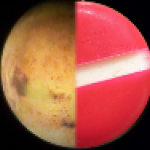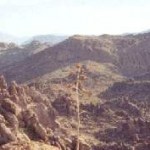Mars
Finally, a chance to catch up a bit ... !
Yasur erupting in May of 2010.
Some news from the world of volcanoes:
The BBC has a series of videos one the fallout from the Eyjafjallajökull eruption - including a look at the area around the volcano and how the economy has been affected by the eruption. However, things seem pretty quiet at the summit of the Eyjafjallajökull summit where snow can begun to settle without melting - and the Icelandic Met Office appears to think that the eruption is more or less (but not officially) over. And take this press release as you will, but a recent study…
Mars Reconnaissance Orbiter image of a potential plume on Pavonis Mons.
There are reports tonight that the Mars Reconnaissance Orbiter photographing the Martian surface noticed an odd plume near the summit of Pavonis Mons. The initial guess was that this plume might have been fog or an new impact on the Martian surface, but the continued presence of the plume might suggest that it is not a transient feature. One suggestion is that these could be a volcanic plume.
Now, Mars has been very volcanically active in the past - in fact the youngest flows could be as young as 20 million years old, so…
Somehow I haven't posted a bunch of interesting items collected over the last few weeks, so I need to catch up. A pre-emptive hat tip to everyone who has sent me links or notes that might seem familiar in this post.
Tungurahua in Ecuador erupting in 2000.
First off, those of you looking for information on the Haitian earthquake that devastated the capitol Port Au Prince, Highly Allochthonous has post on the tectonics of the quake. Right now, it is hard for me to come up with a worse location in terms of devastation for a quake to have hit in the Caribbean Basin.
Back in volcano news, a lot…
Peter Sinclair is remixing some of his Climate Crock of the Week videos to improve the sound quality.
I would like to use this Mars Attacks! episode as an opportunity to close the Mars is Warming too thread.
Watch and learn:
Again, sorry about the paucity of posts. Getting prepared to move 3/4 of the way across a continent will do that. Look for the next Volcano Profile, this time for Erebus in Antarctica, to be posted sometime in the next week or so.
We did get some news over the weekend of a large eruption at Shiveluch. The volcano in Kamchatka has been active all summer, but on Saturday it produced a 5,000 meter / ~23,000 foot ash plume. This was accompanied by 170 earthquakes and multiple avalanches, likely produced by the collapsing dome on the summit of the volcano. There is a little more information about…
This post is written in response to the contest I posted on my Twitter feed earlier today:
SciencePunk challenge: give me two unrelated topics and I will attempt to write a blog post combining them. Your time starts now.
Of several excellent and perplexing replies, I decided to seize the gauntlet thrown down by Martin of The Lay Scientist blog:
@SciencePunk Pigs, and the flu. No? Oh alright... erm... Mars and cheese.
So here it is Martin!
* * *
If you heard the words "time reversal technology" you'd be forgiven for thinking it was a plot point from the new Star Trek movie. Yet across the…
Brought to you by Max Cannon, creator of Red Meat and also the dude who helps run the awesome independent Loft Cinema here in Tucson:
Hilarious...
Also, if you haven't caught it yet, don't forget to check out this week's Carnival of Space, where we have an entry about actually seeing a supernova go off.
Good news for science from... the Vatican? No joke. Father Gabriel Funes, director of the Vatican Observatory and chief astronomer for the Pope, has just issued a public statement stating the following things:
Intelligent beings could exist in outer space.
Life on Mars cannot be ruled out.
The search for extraterrestrial life does not contradict belief in God.
Next year, the Vatican is organizing a conference to mark the 200th anniversary of the birth of Charles Darwin.
Whoa. And whoa's wobbly cousin, woah. Did I just step into the 21st century? After my post last week on what Americans…
And if the band you're in starts playing different tunes
I'll see you on the dark side of the Moon.
One of my favorite readers, Zrinka, asks us why we're only able to see one side of the Moon from Earth. Seriously, look at the different phases; we always see the same side of the Moon:
How does this happen? Well, the Moon makes one revolution around the Earth about every 29 days, and that's what causes the Moon phases. But the Moon also rotates once every 29 days also. Because of this, the same side of the Moon always faces the Earth:
We call this "being locked." We're not the only system…
Those of you who know me know that I'm unhappy living here in Arizona. The landscape and ecosystem of the Sonoran Desert, while beautiful to many, is too dry, rocky, and devoid of life for me to enjoy living here.
After my time here, I've decided that, were it somehow offered to me, I would probably pass on the opportunity to go to Mars. And so I present to you a little game I call "Mars or Arizona," where I will show you some pictures, and you get to guess which ones are pictures of Mars and which ones are pictures of Arizona. Sound easy?
Well let's bring on the pictures, and see if you…
So in a recent column I told you all the problems with having water on Mars in recent history -- namely that the atmosphere is too thin to have supported it. But many of you have (rightly) pointed out to me that there is some evidence that there could have been water on Mars a very long time ago, and that would explain some of the major features on Mars.
But one problem that remained is this: where are the carbonate deposits at the bottoms of these so called streambeds or dried-up lakes? Well, over the weekend I got an interesting email from National Geographic Magazine about Holden Crater on…





